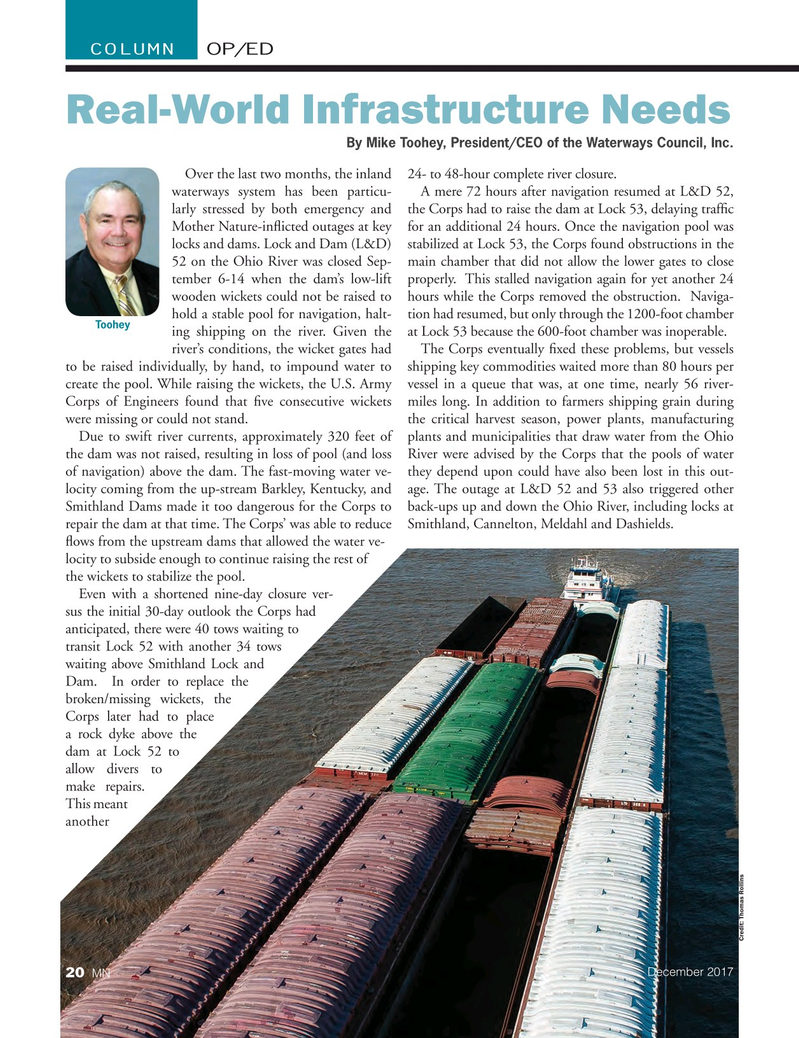
Page 20: of Marine News Magazine (December 2017)
Innovative Products & Boats- 2017
Read this page in Pdf, Flash or Html5 edition of December 2017 Marine News Magazine
COLUMN OP/ED
Real-World Infrastructure Needs
By Mike Toohey, President/CEO of the Waterways Council, Inc.
Over the last two months, the inland 24- to 48-hour complete river closure.
waterways system has been particu- A mere 72 hours after navigation resumed at L&D 52, larly stressed by both emergency and the Corps had to raise the dam at Lock 53, delaying traf? c
Mother Nature-in? icted outages at key for an additional 24 hours. Once the navigation pool was locks and dams. Lock and Dam (L&D) stabilized at Lock 53, the Corps found obstructions in the 52 on the Ohio River was closed Sep- main chamber that did not allow the lower gates to close tember 6-14 when the dam’s low-lift properly. This stalled navigation again for yet another 24 wooden wickets could not be raised to hours while the Corps removed the obstruction. Naviga- hold a stable pool for navigation, halt- tion had resumed, but only through the 1200-foot chamber
Toohey ing shipping on the river. Given the at Lock 53 because the 600-foot chamber was inoperable. river’s conditions, the wicket gates had The Corps eventually ? xed these problems, but vessels to be raised individually, by hand, to impound water to shipping key commodities waited more than 80 hours per create the pool. While raising the wickets, the U.S. Army vessel in a queue that was, at one time, nearly 56 river-
Corps of Engineers found that ? ve consecutive wickets miles long. In addition to farmers shipping grain during were missing or could not stand. the critical harvest season, power plants, manufacturing
Due to swift river currents, approximately 320 feet of plants and municipalities that draw water from the Ohio the dam was not raised, resulting in loss of pool (and loss River were advised by the Corps that the pools of water of navigation) above the dam. The fast-moving water ve- they depend upon could have also been lost in this out- locity coming from the up-stream Barkley, Kentucky, and age. The outage at L&D 52 and 53 also triggered other
Smithland Dams made it too dangerous for the Corps to back-ups up and down the Ohio River, including locks at repair the dam at that time. The Corps’ was able to reduce Smithland, Cannelton, Meldahl and Dashields.
? ows from the upstream dams that allowed the water ve- locity to subside enough to continue raising the rest of the wickets to stabilize the pool.
Even with a shortened nine-day closure ver- sus the initial 30-day outlook the Corps had anticipated, there were 40 tows waiting to transit Lock 52 with another 34 tows waiting above Smithland Lock and
Dam. In order to replace the broken/missing wickets, the
Corps later had to place a rock dyke above the dam at Lock 52 to allow divers to make repairs.
This meant another
Credit: Thomas Rollins
December 2017
MN 20

 19
19

 21
21
